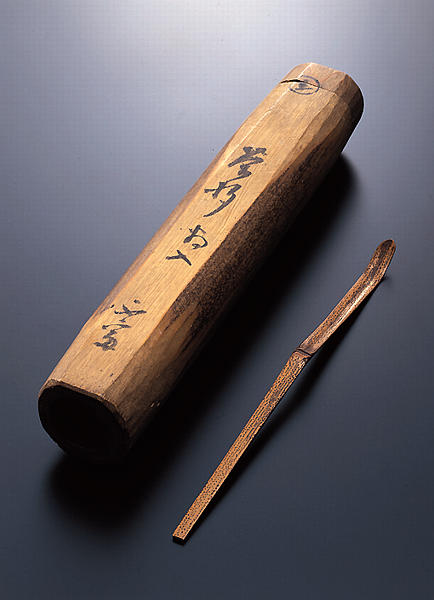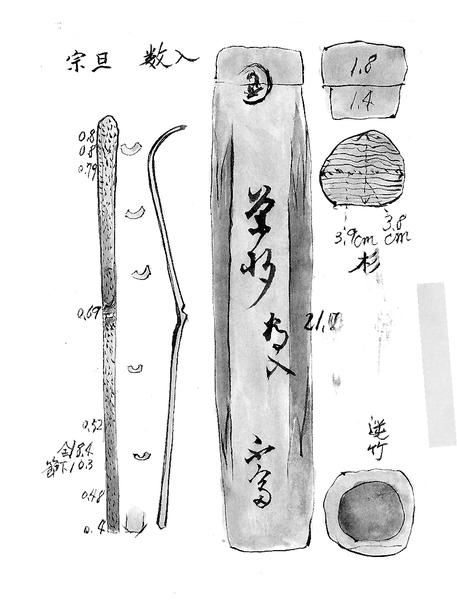Tea Scoops, known as KAZUIRI by Sen no Sotan
- Early Edo period
- 17c
- Bamboo
- H-18.4
- Formerly in the collection of Masuda Don'no
Catalogue Entry
by Sen-no-Sotan
Edo period, 17th century
Bamboo
Length, 18.4cm
Sen-no-Sotan (1578-1658) was the son of Shoan and grandson of Sen-no-Rikyu, who began Sotan's Zen training by placing him in the position of page to Shun'oku Soen. After Rikyu's suicide, Shoan was called back to Kyoto, and Sotan left the priesthood and
returned to the Sen family. In 1600 (Keicho 5), Sotan inherited the title of head of the Sen family from Shoan, becoming the third generation of the Sen family. At the time, the
beautifully quiet elegance of Kobori Enshu's style of tea was extremely popular among
the rising military aristocratic society. By contrast, Sotan continued the spirit of his
grandfather's wabi tea aesthetic, gathering quite a following among the aristocrats, Zen
clergy, and men and women of letters in Kyoto. Sotan made a number of bamboo tea
scoops, and his representative works include "Matsukaze," "Yoroboshi," "Futarishizuka,"
"Samidare," and "Higuchi."
The present work, Kazuiri, consists of 5 scoops today, and yet the large size of their
container would seem to indicate that originally there may have been 2 or 3 more scoops
included in the set. The container was inscribed "Kazuiri," which literally means "holds
many." Similarly, "Futarishizuka," or literally "two qwiet," consists of 2 scoops, while the
work known as Bonsei Dokyo Ryuja "Konzatsu" may have originally held some 8 or 10
scoops. However, this last container is damaged and quite worn, and today it only
contains 2 scoops. The 5 scoops included in the present "Kazuiri" were made of unusual
kinds of bamboo, and they were all included in a large container marked "Kazuiri." 2 of the 5 are particularly unusual, one made of meguro bamboo and one of jicchiku bamboo.
The other 3 consist of one made of meguro bamboo with its tip curved into a bow shape
with a black band. Another is the only one of the 5 made of smoked bamboo. This smoked bamboo scoop has traces of knot marks, yet it is a fine tea scoop. One other is a joint of white bamboo with a great deal of goma dotting at the node. Meguro bamboo tea scoops are known to have been made by Shokado and Fujimura Yoken, but they are extremely
rare.
This meguro bamboo tea scoop has a black band that penetrates from the tip to the mid-node. Meguro bamboo is grown only in Sumoto city, Awaji Island and is an extremely rare form of pale bamboo discovered by Dr. Muroi that has been named a Protected Species by the Japanese government in recent years. The single node is banded with black edges overall, and the reverse shows the same banding.
The final tea scoop in this group is the only jicchiku goma bamboo tea scoop by Sotan
that is known to exist. Jicchiku is not bamboo that has grown from a shoot, but rather is a kind of bamboo where the stem of the bamboo is underground and emerges at a sharp
curve to push above the ground and grow. This means that there is a deep hollow from
the root area, and while normal bamboo has hollows above and below the node, but no
hollow in the reverse space, jicchiku, on the other hand, has a hollow that continues
through this reverse space. Given the extreme rarity of this jicchiku tea scoop by Sotan,
I have included a life-size sketch of the scoop. MN

